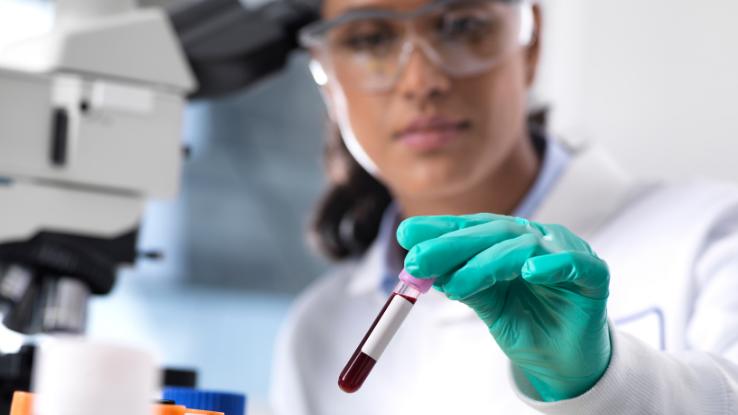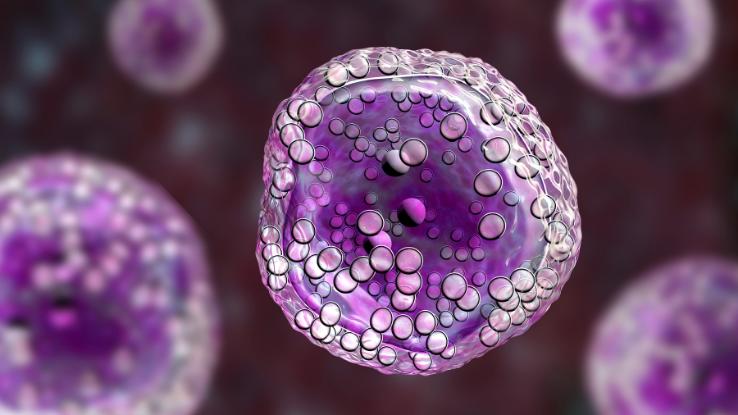What Is Lymphoma? Hodgkin & Non-Hodgkin Lymphoma, Explained

Lymphoma is a type of blood cancer that affects cells of the immune and lymphatic systems, known as lymphocytes. Lymphocytes are white blood cells that are key in defending against foreign pathogens. Lymphocytes are broken down into two major subgroups: B lymphocytes and T lymphocytes, which are commonly referred to as B cells and T cells respectively.
To this end, lymphoma occurs when there is a malignant transformation of either the B or T cells, and they grow rapidly and uncontrollably. The Leukemia and Lymphoma Society estimates that there are just under 800,000 people living with, or in remission from, lymphoma in the United States.
Subtypes of Lymphoma
There are two main types of lymphoma:
- Hodgkin lymphoma (HL)
- Non-Hodgkin lymphoma (NHL)
Hodgkin lymphoma, also known as Hodgkin disease, is named after Thomas Hodgkin and is characterized by the presence of an abnormal cell called a Reed-Sternberg cell, seen under the microscope. Reed-Sternberg cells typically originate from B lymphocytes and are quite large in size when compared to other cells. The main difference in classification that helps a physician make a diagnosis of NHL is the absence of Reed-Sternberg cells.
Hodgkin lymphoma is less prevalent than NHL, and typically occurs in individuals between the ages of 15 and 40, or anyone who is 55 or older. NHL is one of the most common forms of cancer among men and women, and can be split into multiple subgroups depending upon the appearance and characterization of the malignant lymphocytes.
Signs & Symptoms Associated With Lymphoma
Symptoms of HL and NHL are extremely similar, and can be quite vague. Common symptoms of lymphoma include:
- Swollen lymph nodes (particularly swelling not associated with pain)
- Excessive night sweating
- Enlargement of the spleen leading to abdominal pain
- Unintended weight loss
- Unexplained fever
- Itching
- Chills
- Fatigue
- Shortness of breath
The majority of these symptoms are nonspecific, meaning they may be attributed to conditions unrelated to lymphoma or other cancers. However, if you experience one or more of these symptoms for a prolonged period of time, you should see your healthcare provider to determine the best course of action.
Who Is at Risk for Lymphoma?
While research has determined lymphoma is caused by the abnormal overgrowth of immune cells called lymphocytes, the precise cause for the mutation causing the overgrowth remains unknown. There are several risk factors that may increase your risk of developing lymphoma.
Risk factors for Non-Hodgkin lymphoma include:
- Age: Those above 65 years old are at an increased risk for developing NHL.
- Sex Assigned at Birth: Males tend to be diagnosed with NHL more commonly than females.
- Prior infection: Certain infections can change lymphocyte DNA directly, increasing the risk of them developing into cancerous cells. These infections include Epstein-Barr virus (EBV), human T-cell lymphotropic virus (HTLV-1), and human herpesvirus 8 (HHV-8).
- Family History: Those with a first-degree relative who has had NHL at some point in their life have a higher risk of developing NHL as well.
- Weakened Immunity: Those who have human immunodeficiency virus (HIV), have received an organ transplant or are taking immunosuppressive drugs, or have certain hereditary conditions such as Wiskott-Aldrich syndrome, are at a greater risk of developing lymphoma.
- Chemical Exposure: Certain pesticides and insecticides have been associated with an increased risk of NHL, however that risk is not fully confirmed as research is still ongoing. In addition, prior use of chemotherapy drugs such as methotrexate may increase your risk of developing NHL.
Risk factors for Hodgkin lymphoma include:
- Age: Those between the ages of 20 and 39 years old, or above 65 years old, are at an increased risk for developing HL.
- Sex Assigned at Birth: Males tend to be diagnosed with HL more commonly than females.
- Prior Infection: A prior infection with the Epstein-Barr virus (EBV) or Helicobacter pylori (H. pylori) can increase your risk of developing HL.
- Family History: Those with a first-degree relative who has had HL at some point in their life have a higher risk of developing HL as well.

Diagnosis of Lymphoma
If a person displays signs or symptoms that might suggest some form of cancer, a physician will likely order a series of blood tests to be performed as an initial step, in addition to performing a physical exam to check for swollen lymph nodes.
Your physician may order a tissue sample of any swollen lymph nodes, known as a biopsy. This tissue sample will be evaluated under a microscope to determine what type of cells are present, and if they are present in normal concentrations. A bone marrow biopsy may also be necessary. During this procedure, a needle is inserted into a bone in the hip and a sample of bone marrow is collected for investigation in a laboratory. Lastly, your physician may request imaging studies that can evaluate the presence of any tumors or metastasis (tumor spread) in the body.
Depending on the results of these diagnostic measures, your physician may refer you to a specialized cancer physician known as oncologist. You may undergo further testing with a specialty doctor.
Lymphoma Treatment
Lymphoma can be treated in several ways, and in some cases treatment may be deferred so as to not cause negative side effects earlier than is necessary.
- Radiation Therapy: High-powered energy beams are used to decrease the size of any lymphoma cell masses. The radiation is restricted to only the areas of the body that are affected by lymphoma.
- Chemotherapy: A combination of drugs that targets quickly-growing cells (such as cancer cells) is administered, sometimes in combination with radiation therapy to achieve the best outcome.
- Bone Marrow or Stem Cell Transplant: This form of treatment is less commonly utilized, but involves suppressing your immune system via chemotherapy and radiation, then infusing healthy bone marrow cells into your body so they can rebuild your bone marrow supply.
- Surveillance: In the case of a slow-growing cancer, such as non-Hodgkin lymphoma, your oncologist may decide to monitor the development of your cancer until it reaches a point where it interferes with your daily life, at which point you may be started on a chemotherapy or radiation regimen.
Prognosis
The prognosis is generally better for those with HL than NHL. It’s estimated that more than 86% of patients diagnosed with HL survive five years or more, with about 70% of patients diagnosed with NHL survive five years or more. Prognosis will depend on age at diagnosis, stage of disease and how well someone responds to treatment.
Support for Lymphoma Patients & Caregivers
It is no small matter to be told you have cancer, or to be supporting someone who has been told they have cancer. Often, caregivers or the emotional support system of a person undergoing cancer treatment can feel just as troubled by the process as the patient themself. If you are patient, make sure you lean on your support system to help you through the tough days. If you are a caregiver or close to someone undergoing cancer treatment, you should also make sure you have an outlet for your emotions.
The Leukemia & Lymphoma Society offers many support groups for patients and families going through cancer treatment. The family support groups offer a place to share information, talk with others who are going through the same experiences, and receive education from licensed mental health professionals. These sessions are often free to attend. More information can be found on the LLS website.
Resource Links:
- “Hodgkin (HL) and Non-Hodgkin (NHL) Lymphoma” via Leukemia & Lymphoma Society
- “Lymphoma” via Mayo Clinic
- “Lymphoma” via American Cancer Society
- “What Is Lymphoma?” via Lymphoma Research Foundation
- “Support Groups” via Leukemia & Lymphoma Society
- “Non-Hodgkin Lymphoma Risk Factors” via American Cancer Society
- “Hodgkin’s vs. non-Hodgkin’s lymphoma: What’s the difference?” via Mayo Clinic





